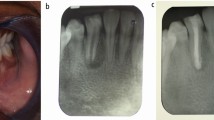Key Points
-
A case report of a finger bitten through in a public house brawl.
-
This is a rare injury and would have required considerable force.
-
It is postulated that premolar teeth were involved in producing the injury.
Abstract
A case is reported where a forefinger is 'amputated' by a human bite. This type of extreme biting injury is uncommon and probably represents tearing by the premolar teeth rather than a clean bite by incisor teeth.
Similar content being viewed by others
Main
Bite injuries are relatively common and are seen in a variety of circumstances including assaults, rape, murder and child abuse.1 The marks left on the skin may be of evidential value in identifying the biter or in eliminating from suspicion those suspected of making the bite mark.2 Despite the large forces that may be generated in biting it is uncommon to see deep penetration of the skin by the teeth. The reason that this is seldom seen is that most bites occur over unsupported soft tissue. Common areas where bite marks may be found include the arms, neck, breasts, trunk, cheeks and legs. Only where bone or cartilage is close to the surface of the skin can tooth penetration be noted. Recently a high profile case involving the boxer Mike Tyson showed the vulnerability of ears. Apart from ears the other area where tissue loss may occur because of a bite is the tip of the nose. Bite marks of the fingers, while relatively common in assaults, do not often lead to tissue loss. Severance of a substantial length of fingertip by human teeth is rare and would require considerable force to cut through the supporting bone — see case report.
Comment
The case report represents a very unusual bite injury and is the most damaging bite injury, in terms of tissue loss, we have seen in more than 40 years of combined forensic experience. Considerable tearing forces must have been needed to inflict this injury and we postulate that premolar teeth were involved to tear the finger away.
Case report
Police Officers were called to attend a dispute between two men in a Dundee public house. During the course of the fight a portion of forefinger was bitten away from one of the men. The fingertip that was found by police on the floor of the bar could not be surgically reattached and was subsequently sent to us for forensic examination. The tip of the finger distal to the distal interphalyngeal joint had been detached. The ruptured bone had an elliptical contour some 8 ′ 4 mm in size. The flexor digitorum profundus tendon could be seen emerging into a dense periostium. There was no evidence of an extensor tendon as the break was at the base of the nail bed. Figure 1 shows the 'amputated' fingertip and attached medial and distal neurovascular bundles. The vascular elements were sufficiently long to have been worn away directly from their origin on the superficial palmar arterial arch. Tooth marks were noted on the skin. These were of such size that we formed the opinion that they were likely to have been caused by incisor teeth. In order to have detached the bony tip of the digit we also assumed that the injury involved the tearing away of the finger tip against the resistance of the bone and residual non-incised soft tissue (including the flexor digitorum profundus, the extensor tendon and the joint itself) must, we think, have involved the teeth distal to the incisors.
References
Rothwell B R . Bite marks in forensic dentistry-A review of legal and scientific issues. J Amer Dent Ass 1995; 126: 223–232.
Asku M N, Gobetti J P . The past and present legal weight of bite marks as evidence. Amer J Forensic Med and Path 1996; 17: 136–140.
Author information
Authors and Affiliations
Additional information
Refereed Paper
Rights and permissions
About this article
Cite this article
Drummond, J., McKay, G. Biting off more than you can chew: a forensic case report. Br Dent J 187, 466 (1999). https://doi.org/10.1038/sj.bdj.4800307
Received:
Accepted:
Published:
Issue Date:
DOI: https://doi.org/10.1038/sj.bdj.4800307




